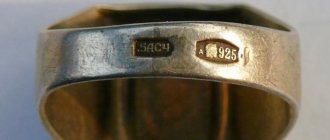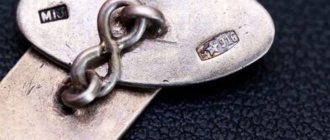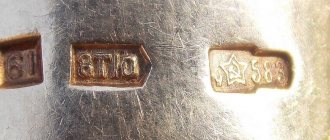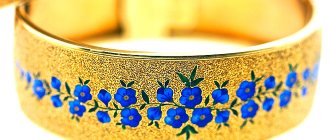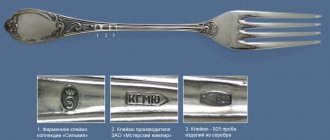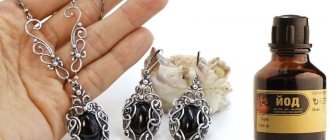Today, science knows more than 80 types of metals. And only eight of them are called noble. Next to gold and the six platinum group metals in this series, silver (argentum) rightfully stands. High ductility, excellent ductility and malleability, immunity to corrosion and oxidation are unique properties that determine its widespread use. Compounds of silver with other metals are especially often used. Thus, 800 sterling silver is often used for the production of cutlery, writing instruments, and decorative items.
800 sterling silver, what is it, what kind of metal?
800 silver is considered a low-grade alloy, which is used primarily for casting cutlery. The “800” stamp on the metal indicates that the product contains 80% pure silver, with the remainder being various impurities.
The alloy corresponds to 19 carats, 12.8 lots or 77 spools.
It is often called the “dining room”, and the peak of its popularity occurred during the reign of Catherine II.
800 silver spoon
Marking of silver in Italy from the mid-30s of the 20th century to the present
In the 20s, a radical government led by Benito Mussolini (Benito Amilcare Andrea Mussolini) came to power in Italy, which set the task of bringing order to the marking of silver. New branding rules were approved in 1935. The system was well thought out - each manufacturer was assigned its own number. The number was enclosed in a rhombus, and two additional letters were applied, indicating the province. Until 1944, fascist symbols - an ax and birch twigs - were a mandatory element of the brand, but after the fall of Mussolini’s regime, the design was removed.
Legislation in 1968 made further adjustments to hallmarks on silver items in Italy. The diamond was replaced by a rectangle with a star on the left side, the individual number and the province designation were retained. This marking of silver is still used today.
Silver items by Italian masters often appear among lots at antique auctions. The Very Immortant Lot features items that can become long-term investments.
800 sterling silver: composition and properties
In its pure form, lunar metal is not used to create jewelry because it does not have sufficient strength. In order to change its casting properties, improve performance characteristics, and increase hardness, the metal is alloyed with various additives.
For 800 silver, the main alloying substance is copper. Sometimes the alloy also contains zinc, aluminum, and less often nickel. The amount of lunar metal in one kilogram of such an alloy is 800 grams, 200 grams are additives.
Due to the increased copper content, the alloy may have a yellowish tint, which is not typical for higher grades. Copper also helps to reduce anti-corrosion properties; the product quickly darkens from air and water environments.
LiveInternetLiveInternet
This photo shows some modern and antiquated silver samples
Standard silver standards in force in Russia, Ukraine and the CIS countries have the following numerical values: 800, 830, 875, 925, 960 and 999. Other countries may have their own unique silver samples, the content of pure noble metal in such samples, may be determined historically.
800 silver
800 silver bowl, made in Russia.
800 sterling silver with foreign mark.
- This is low grade silver.
- The alloy of this sample has a slightly yellowish tint.
- Contains: 80 percent silver and 20 percent copper.
- Has excellent casting properties.
- It oxidizes more intensely than other standard silver alloys in the air and turns yellow.
- Has high mechanical strength.
- The alloy is 875, often equated by jewelers to 375 gold.
- This low-grade silver is often used to make tableware and is less often used in the production of jewelry.
- 830 silver tray, made in Russia.
- This is a low grade alloy.
- It contains: 83 percent silver.
- Its characteristics are almost no different from the previous alloy.
- Jewelers often undertake to make jewelry from this alloy.
875 silver
Silver plate, stamped 875, made in Russia.
- 875 silver is standard high-grade silver, which is the border between low-grade and high-grade alloys.
- The pure silver content is 87.5 percent.
- Less than other standard alloys, 875 alloy is prone to oxidation in air.
- It also retains its bright white-silver color very well, like a pure noble metal.
- It is mechanically a high-strength alloy.
- The alloy of this sample was very popular - in tsarist times and in the Soviet Union.
- Today this alloy is in wide demand - in the Russian Federation.
- The alloy of this sample is also called “Russian silver”.
- Russian jewelers willingly undertake to make various types of household and jewelry items from it.
- This alloy is often used to produce fine silverware and jewelry.
- This high-grade alloy is also in great demand abroad.
84 sterling silver
An antique silver salt shaker with a 84-karat hallmark, where a lady in a kokoshnik looks to the right.
- 925 sterling silver is characterized as a unique, very high quality alloy.
- This alloy is also called “sterling silver” or simply “sterling”.
- It is synonymous with the concept of “coin silver”.
- Sometimes called “pure silver”.
- Contains 92.5 percent pure noble metal.
- This alloy has high ductility properties.
- Easily subject to shaping.
- It has elastic and hard properties.
- Retains a bright shine - like pure silver.
- It is considered the world leader among all known standard jewelry alloys.
- Today it is rightly called the “international silver standard.”
- Most of the world's silver jewelry is made from this type of alloy.
- It has ideal: physics - chemical characteristics.
- This alloy is slightly susceptible to oxidation by oxygen.
- When properly stored, sterling silver retains its original silvery appearance for a long time.
- Jewelry made from this popular alloy has the appearance of sterling silver and is very durable.
- This is a universal alloy from which jewelers can make almost all jewelry.
- Sterling alloy is widely used to make: high-end silverware, jewelry, filigree silverware, bullion coins, and even ionizers to ionize water.
960 silver
Wedding silver ring, highly polished, made in Russia, with a 960 hallmark and a lady in a kokoshnik facing to the right.
- Engagement silver ring, rhodium-plated, made in the former USSR, with a 960 hallmark and a five-pointed star, inside of which are the symbols of the Soviet Union: the hammer and sickle. Silverware containing Soviet symbols, usually a star with a hammer and sickle, indicates that the silverware or silver jewelry was made in the former USSR.
- 960 alloy is a high-grade silver alloy.
- Silver alloy with the number - 960, contains about - 96 percent pure noble metal.
- 960 alloy, like 925 silver, contains a small amount of copper.
- According to its characteristics, it is not much different from pure silver.
- Silver 960 has excellent ductility properties, is well processed, polished, slightly oxidized in air, contains a large percentage of silver, its color is very close to pure noble metal.
- This alloy is used mainly where very fine work is required - with enamel or in the manufacture of fine filigree (filigree silver).
- Jewelry made from this alloy looks great. Today, not a single filigree can do without a silver alloy, with the number 960. Silver items made from this type of alloy are very vulnerable and easily change their shape during wear.
- In Russia, it is the maximum permissible for the production of jewelry.
- A unique silver ring made from pure silver.
- Silver alloy 999 is the highest standard, which contains only one percent of various impurities.
- It is also called “high purity alloy”.
- This silver alloy is usually obtained at refineries.
- Today, it has not yet been possible to obtain chemically pure silver, without foreign impurities. Often the alloy of 999 fineness is identified with pure silver or with 1000 fine silver.
- 1000 silver is an abstract concept.
- A soft and easy to process 999 silver alloy, it is extremely rarely used in jewelry production.
- 999 sterling silver is used for the manufacture of small jewelry parts - jewelry or small-sized silver items.
- This alloy mainly serves as a valuable material from which bank silver (coins, bars) and parts for the radio engineering industry are made.
- Pure silver is often used as a decorative and protective coating.
- Electrolytically - pure silver is applied to various objects: silver, brass or copper, to improve their aesthetic properties, or to protect products from the action of an aggressive chemical environment.
- Today, not a single jeweler would risk making large-sized jewelry from pure silver, and a true connoisseur of silver would not want to wear it all the time and would store it carefully in a case.
Non-standard or obsolete silver hallmarks, for example: 720, 750, 916 and 84
Silver table spoon with hallmark 916.
- Silver bowl with 916 hallmark and a five-pointed star with a hammer and sickle. Next to the hallmark mark, there is another mark – the name plate.
- 750 sterling silver engagement ring.
830 silver
Silver cup, stamped 875, made in the former USSR.
Silver tray, hallmarked 875, produced in the former USSR.
Today, in many Russian and Ukrainian museums, as well as in the collections of silver connoisseurs, jewelry silver left over from the distant past has been preserved. Jewelry silver in Tsarist Russia, until 1927, in accordance with the spool system, was branded with spool hallmarks. The spool system for marking silver in Russia was based on the Russian pound. The assay system in Russia was created by the great reformer Tsar Peter the Great, who by his decree defined four hallmarks of silver: 96, 90, 84 and 62. Silver 84 hallmark, today referred to as metric 875 hallmark, was considered the most popular hallmark in Tsarist Russia.
Sterling Silver
Silver ring made in Russia from 925 sterling alloy. There are two hallmarks on the ring: one with the image of 925 standard and a lady in a kokoshnik with her face turned to the right; the other is a brand - a name tag.
Two 925 sterling silver rings, coated with a layer of white rhodium, made in Ukraine.
925 sterling silver ring with pearls and zirconium inserts, made of sterling silver, plated with a thin layer of white rhodium,
is a foreign-made product.
925 silver saucer, early 19th century, marked Sterling, well preserved to this day.
999 silver
Engagement silver ring, made in Russia, with a 999 hallmark and a lady in a kokoshnik facing to the right.
Bank silver bar, weighing 500 grams, made in Russia from pure silver.
The investment silver coin “St. George the Victorious” was issued by the Central Bank of the Russian Federation in 2009, with a nominal value
three rubles, 999 fine and weighing 31.1 grams.
Sample 800: narrow application and wide distribution
The scope of application of 800 sample does not expand over time. The alloy is used to create products that must be durable because they will be subject to daily physical impact.
Cutlery made of 800 silver
Making silverware
Most often, the precious metal is used to make various cutlery.
History of hallmarks on Russian silver
Before the advent of assay supervision in 1700, in the territory of Tsarist Russia only silver products were subject to hallmarking. There was no single standard; artisans and large jewelry factories marked their products with their own mark. The stamp only indicated that the product was made of lunar metal.
The testing system established by Peter I remained virtually unchanged until 1917. According to Peter's decree, four gold and four silver standards were established. The decree protected the interests of bona fide producers, fair competition, and the state itself.
The mark of the tsarist era looked like this: first, the numerical value of the sample in the spool system was indicated, then - the imprint of the female profile in the kokoshnik, and lastly the initials of the foreman or plant manager were indicated. Often the year of manufacture was also indicated on the product.
The silver testing system changed with the Bolsheviks coming to power. The spool system was replaced by the metric system, and the woman's head was replaced by the worker's head. The marking system was revised again in 1958 and was not changed again until the collapse of the Soviet Union.
Assay systems used around the world
Our country currently uses the metric assay system. It shows the number of parts per thousand of pure metal. If you divide this value by 10, you can get its percentage. For example, 585 gold will contain 58.5%, and 925 silver will contain 92.5%.
The karate system is used in many countries around the world. Most European countries and America use it. Pure metal has a purity of 24 carats. If there is only half of it in the alloy, then such a product will have a purity of 12 carats. You can calculate the metric sample from a carat sample using the formula k * m / 1000, where k is the sample in carats, m is the metric sample.
Density of silver depending on the sample
In Tsarist Russia, a spool test was used. Zolotnik was a weight measure that was equal to 1/96 of a Russian pound, approximately four grams.
Labeling in other countries
For European countries, branding begins earlier. Many of them indicate the fineness in carats. The lot or spool system for indicating the purity of the alloy is practically never used anywhere.
English
In the second half of the 12th century, many masters in England had individual marks. They could indicate them on the finished product only after checking by the guild of jewelers.
In 1701, assay offices opened throughout the country, making it easier to control the quality of jewelry work. The mark of those times looked like this:
- The image of a walking lion is a sign of a government institution;
- An image indicating the year of manufacture;
- An image unique to each individual city;
- A stamp indicating payment of taxes;
- Try;
Modern English products do not have a stamp indicating payment of taxes.
French
The oldest mark found on French jewelry dates back to 1272. It reported the name of the master and the city of production.
The oldest hallmark on French jewelry, 1272.
Hallmarking became mandatory in 1672. Since then, the mark has not undergone significant changes. Products from France are marked as follows:
- First, an imprint of the head of Hermes is indicated - a sign that the jewelry has passed the state authentication test;
- The letter designation encodes the production date;
- The sample is indicated last;
German
The first hallmarks of jewelry in Germany date back to 1289. Branding was not mandatory in the country, but eminent masters often indicated their authorship on their works.
It became mandatory in 1548; a new decree required markings on all products with a purity greater than 4 lots. The print contained the lot value, the unique mark of the master, and the identification mark of the reigning monarch.
By 1800, a particularly popular hallmark, the “Celtic Mark,” had become established. It was equal to 800 samples of lunar metal.
In modern Germany, 800 silver remains highly sought after, and the hallmark looks like this:
- A unique sign of a factory or artisan;
- Numerical value of the sample;
- State confirmation sign - a crescent with a crown;
History of the Assay System
Hallmarks, which were placed on silver items from the eighteenth to the early twentieth centuries, indicated their value. From them it was possible to determine when and where the product was made and even which craftsman worked on it. The assay system in Russia was created by Tsar Peter I. By special decree, four samples of silver and gold were determined; the assay system was called spool.
At that time, only the master and the elder had the right to brand products. Selling anything made of precious metal without a hallmark was prohibited. Those who had the right to make impressions were even trained specifically for this.
Already in the nineteenth century, special chambers were equipped for hallmarking silver and other metals. The print itself has also undergone changes. It began to contain the coat of arms of the city where the item was made, the sign of the inspector (initials) and the sample of the metal. At that time, a new assay charter was also adopted, according to which the empire was divided into assay districts, and the mark took the form of a woman’s head in a kokoshnik. The stamp also contained the initials of the head of the district and a hallmark. Since they began to brand a product indicating the place where it was made, it has become possible to recognize the works of great masters.
Mark on a silver fork
Cost of 1 gram of 800 silver
The cost of any alloy depends on the prices for pure precious metals established by the Central Bank of the Russian Federation. To find out how much a particular silver sample costs, you need to multiply the current price of the highest alloy by the required coefficient.
The price of pure silver for 2021 is about 58 rubles per gram.
Then you can calculate the current cost of 800 samples as follows:
58 * 0.8 = 46.4 rubles per gram.
One gram of silver
Ways to install a fake
You can reliably distinguish a fake from a genuine precious metal in jewelry workshops, purchase shops, and pawn shops. If there is no opportunity to contact professionals, you should use the following recommendations:
- First of all, you need to carefully examine the sample on the product. Lack of markings may indicate a fake.
- Try dropping iodine onto an inconspicuous part of the object. Genuine precious metal will darken upon contact with the substance.
- The new product must not have scuffs, scratches or other defects. This appearance is only acceptable for antique items.
- You can try to gently scratch the surface with a needle. If a different color of metal appears at the site of the scratch, this is a fake.
Types of silver hallmarks in Russia
Now the most common alloys are 925 and 875 silver. Most often, silver hallmarks have the shape of an oval with cut off sides, an image of a woman’s head in a kokoshnik, turned to the right. In the lower left corner there is a letter that indicates the place where the product was tested; the numbers on the left indicate the alloy sample. Products may also be branded as follows:
- The main hallmarks are the marks called the letters “A”, “B”, “C”, “G”. Their presence in the product is sufficient. The stamp of the letter “A” looks like the head of a woman in a kokoshnik in a circle, outside of which there may be a sample. The letter “B” stamp has the standard appearance described above. “B” and “G” have a similar appearance to that corresponding to “A” and “B”, except that instead of a woman in a kokoshnik, they depict a five-pointed star with a hammer and sickle inside. Products made of precious metals were branded with such imprints in the USSR. They are not used now.
- Additional hallmarks include hallmarks of the letters “D”, “E”, “Zh”, “Z”. They have no independent meaning. This mark in itself is not enough to determine the quality of the product; the main one should be next to it. Nowadays only the letter “D” stamp is used. It looks like a rectangle with rounded ends, inside of which there is a sample designation. The letter “E” was used to mark products that did not correspond to the declared standard. The remaining two have been used previously.
- Another form of the main stamp, the letter “B,” denotes products intended for shipment abroad. They differ from the main one in that instead of a woman in a kokoshnik, they depict a ship. This test is enough.
- Products can also be branded with combined hallmarks. They combine the main mark with the “name”, or the mark of the master, which indicates, in addition to the region where the product was tested, the manufacturer himself.
- For the 50th anniversary of the October Revolution, a temporary stamp was introduced, dedicated to the anniversary in honor of the space explorers; it was valid for two months of 1967.
- Until 1994, for church items it was allowed to use only the stamp of the letter “D”, without the main one.
- Until 1997, medals and coins were marked with letters indicating the precious metal in accordance with chemical designations, with a hallmark next to it. If products do not have artistic value, they are now branded in accordance with generally accepted standards.
- There are several sampling systems. Nowadays metric is used, but until the twentieth century, spool-type was used.
The mark can be placed in several different ways. Most often it is applied mechanically. But if the product is thin or especially expensive, a laser type of application can be used. Since items made from precious metals are subject to abrasion, you must be especially careful with laser-applied jewelry. If they are subjected to constant mechanical stress, the sample may be erased.
Silver samples according to GOST
GOST 30649-99 establishes 6 silver standards. You can see their composition in the table below.
| Try | Silver content | Impurity content |
| 800 | 80% | 20% |
| 830 | 83% | 16% |
| 875 | 87,5% | 12,5% |
| 925 | 92,5% | 7,5% |
| 960 | 96% | 4% |
| 999 | 99,9% | 0,1% |
Causes of silver blackening
The most common cause of blackening is the oxidation of copper contained in the alloy. Human sweat, which is a waste product from the body, contains sulfur, which can also cause darkening of lunar metal.
Low-quality materials also darken from contact with cosmetics, water, household chemicals, and aggressive reagents.
800 alloy cutlery usually has an additional protective coating, so it does not darken from contact with food and water.
Recommendations for the care and storage of silverware
Silverware should be stored separately from other items, preferably inside special boxes or cases.
It is recommended to purchase a detergent suitable for silver items. It is necessary to wash dishes immediately after eating and do not allow food to dry on the surface. Precious tableware should be washed separately so as not to accidentally scratch it on other dishes.
It is recommended to regularly clean items with soap or soda solutions.
Do not wash low grade metal products in the dishwasher.
How to distinguish silver from other metals
Unlike gold, whose yellowish sheen is difficult to confuse with anything else, silver resembles many base metals. Therefore, it is important to know how to visually distinguish white gold from silver, platinum or tin, so as not to mistakenly purchase a penny trinket.
Silver jewelry has a grayish tint
The first thing you need to pay attention to if you need to distinguish silver from platinum is the size of the jewelry. Platinum is too expensive a metal to make massive rings or earrings from. Another sign is color. Silver jewelry has a grayish tint, while platinum jewelry is much lighter and has a white cast.
White gold is also easy to distinguish from silver. Silver, as mentioned above, has a gray tint, while white gold turns more yellow. In addition, silver items will be much less shiny than white gold items.
Tin is not very different from silver, so identifying the metal by eye in this case will not be easy. However, you can use the above method with iodine - if after applying the solution the metal turns black, then you have tin.
You can distinguish silver from palladium using nitric acid - it can be bought at a pharmacy or a specialized online store. Be careful and be sure to use gloves when working with acid! If you drop the substance onto silver jewelry, it will leave a dark mark. And if it's palladium, it will turn red.
How to check silver at home for authenticity (video)
Reviews
For several years, the whole family has been using silver cutlery from the Sokolov brand, which corresponds to 800 standard. We only take out the set for holidays and try to take care of it. The appliances look as attractive as the day they were purchased.
Masha L., Kastroma
Lydia I. g, Ivanovo
Silver spoons for the child were brought as a gift from Italy. On the handles of the spoons I saw the number 800 and a five-pointed star. It turned out that the picture means the country of origin, and the number means the sample of silver. I really liked the gift.
I discovered someone’s forgotten set of silver salt shakers in a recently purchased house. The items apparently date back to the times of the USSR, I realized this from the 800 mark next to the worker’s head. The set is clearly of historical value; I kept it as a souvenir.
Vitaly N., Yaroslavl
